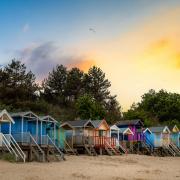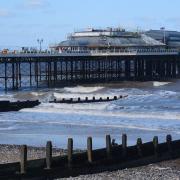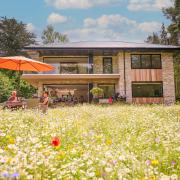Step back
A new circular stroll links many of the historic highlights of Blakeney.
It takes in the Quay, High Street and Pastures and features buildings such as the 15th century Guildhall undercroft which went on to be used as storage for grain, coal and fishing bait and, during the First World War, was a temporary mortuary for shipwrecked sailors. A secret tunnel (so secret it has never been found) is said to run to the remains of a friary. The violinist and his white dog who ventured in many centuries ago and were never seen again. They do, however, appear on the village sign.
The Blakeney Trail was created by the Arts Society Glaven Valley which has previously created trails around the churches of Cley and Glandford. The 220-strong society welcomes new members, organises talks and visits, and is part of a national group of arts societies.
Its new Blakeney Trail is available around the village as a leaflet or by downloading a QR code or from the website theartssocietyglavenvalley.org.uk.
Local homes for local people
Blakeney was decades ahead of the curve when regular-visitor-turned-resident Norah Clogstoun realised villagers were living in terrible conditions. After failing to persuade landlords to make repairs she borrowed enough money to buy and repair a row of five tumbledown cottages and rent them at affordable prices to local people.
She launched Blakeney Neighbourhood Housing Society in 1946 which now provides affordable homes for local tenants in 43 houses in Blakeney and nearby villages.
As you follow the Blakeney Trail look out for its distinctive blue-and-white plaques.

Quay, sea and pirates
Blakeney had a bustling port until the early 20th century, when the harbour silted up and only small boats could navigate the creek out to the open sea. In medieval times ships from across the known world docked here to unload cargo including spices and textiles. Fishing boats sailed to Iceland to catch cod, preserving it in salt and bringing it back to sell all over the country.
Centuries ago some of Blakeney’s sailing fraternity were notorious as pirates, setting out from the village to capture ships and their rich cargoes. Bolshy Blakeney is also said to have refused to send a vessel to join the fleet to fight the Spanish Armada.
Blakeney’s twin-towered church high above the village was once used to guide boats into the harbour and visitors can see medieval graffiti of sailing ships inside.
Regatta – and 150 years of the greasy pole
Fancy walking the greasy pole, gillying (crabbing), or watching sailing races from beautiful Blakeney Quay? Blakeney Regatta includes sports on the playing field on August 5 and the Sailing Club stages its regatta races on August 19 and 20.
The annual spectacle of people trying to get to the end of a slippery pole before tumbling into the water has been entertaining the people of Blakeney for at least 150 years. This year’s greasy pole contest, following gillying and sandcastle competitons, is on the evening of August 8.
What’s the point?
Some of Blakeney’s most famous residents are its seals.
Blakeney Point, a four-mile spit of shingle and sand-dunes growing longer every year, is home to England’s largest seal colony, with more than 4,000 grey seal pups born every winter. The first known Blakeney Point seal birth was just 35 ago. It is also an internationally important haven for birds and a warden lives out at Blakeney Point through every spring and summer, helping protect wildlife including several types of terns which nest on the national nature reserve.



























